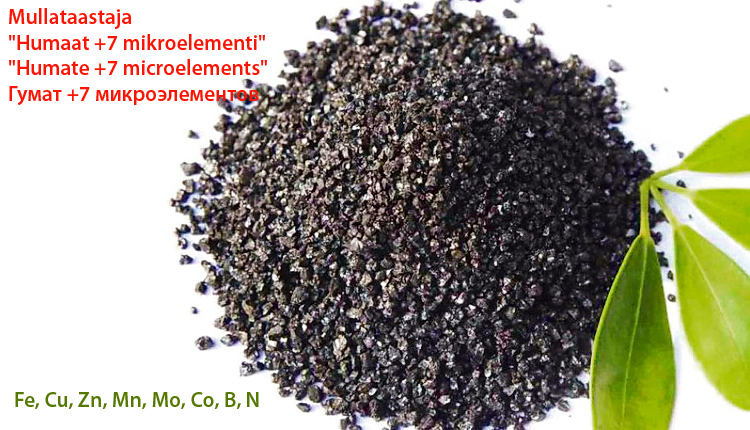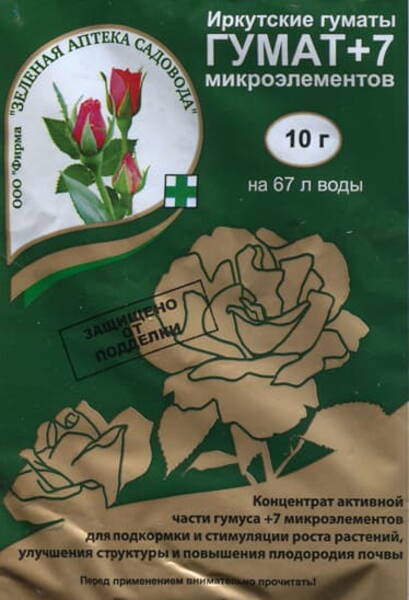Sodium humate, enriched with microelements, is desirable to be CONSTANTLY used on ALL types of crops, since it:
- provides an increase in yield by 25-40% and a reduction in ripening time by 10-12 days;
- increases the efficiency of assimilation by plants of minerals and microelements, reducing the rate of their introduction by 30-40%;
- increases the content of vitamins, sugars and other nutrients in fruits;
- intensifies metabolic processes in the plant cell, reducing the content of nitrates by 2 times;
- increases the immunity of plants to diseases;
- in combination with microelements makes plants resistant to drought and frost;
- reduces acidity and improves soil structure;
- stimulates the development of all soil microorganisms, which contributes to intensive recovery and formation of humus in soils, humus and composts;
- binds the products of technogenic pollution (compounds of mercury, lead, pesticides, radionuclides, etc.) and prevents their entry from the soil into the plant and therefore ensures the ecological purity of the product;
- promotes the development of a powerful root system.
Method of using the drug: Dissolve 1 g of the drug "Humate + 7" in 10-15 liters of water, water at the rate of 4-5 liters per 1 sq. meter. The drug is used 3-4 times per season during the period of active growth (budding, with fruit ovary and their filling). Interval 2 weeks.
Pre-sowing soaking of seeds: solution for soaking - 0.5 g of the drug to dissolve in 1 liter of water. Soak the seeds for 1-3 days.
Soil processing: evenly spread the preparation over the soil surface before digging or loosening at the rate of 10 g per 2-3 sq. M.
Treatment of plants: dissolve the contents of the package (10 g) in 100-200 liters of water, water the plants and soil at the rate of 4-5 liters per 1 sq. M.
Seedling crops: 1st watering of the soil after sprouting, 2nd - after planting seedlings in the ground, 3rd - after 10-15 days.
Seedless crops: 1st watering after sowing seeds, 2nd - after germination, 3rd - 15 days after 2nd watering.
Strawberries, berry bushes: 1st treatment (watering or spraying) - in the spring on the first leaves, 2nd and 3rd - with an interval of 10-15 days.
Indoor plants: watering indoor plants during the period of active growth 3 - 4 times with an interval of 10 - 15 days.
In autumn: abundant watering with a concentrated solution of "Humate + 7" (3 g of the drug per 10 liters of water) of all fruit and berry plantations and trees for their better wintering, and when planting (transplanting) - for better survival.
* The use of humates is necessary for all types of soils and for all types of plants. When using manure or plant residues for composting, it must be borne in mind that humates promote the growth of microflora and, first of all, actinomycetes (microorganisms that combine the properties of fungi and bacteria), and they are capable of destroying wood residues (cellulose, hemicellulose, proteins and lignin ), thereby accelerating the processes of natural accumulation of humus. 3 months before applying to the soil, it is useful to process manure, humus and composts with a solution of humates at the rate of 8-10 kg humate for 10 tons of manure or 25 kg of humate for 10 tons of compost, which makes it possible to speed up the composting process and reduce their consumption.
When is humates used?
Annual plants react more strongly to the introduction of humate at the beginning of their development and at the time of the formation of reproductive organs. Woody - after transplanting seedlings and seedlings, when the root system is injured. The same applies to vegetable and ornamental seedlings. Humates are used at all stages of plant development. Start by soaking the seeds. To do this, it is recommended to prepare a solution of 0.5 g per 1 liter of water and soak the seeds in it for a day. Soaking of summer plants (asters, vervains, salvias, petunias, nasturtiums, carnations), as well as "babies" of gladioli, impatiens cuttings, physalis, dahlias, hydrangeas should be done within 24 hours at a temperature of + 20 + 22 degrees.
Further processing with humates is carried out during the growing season. In this case, the consumption of humate is largely determined by the nature of the plant.
Crops such as dill, parsley, lettuce, onion, radish, radish and sorrel do not require a lot of nutrients. Therefore, it is enough to water them 3-4 times over the summer with a 0.01% solution, using 2-3 liters per 1 sq. meter.
Cucumbers and tomatoes are medium nutrient intakes. They are watered with a 0.01% solution of humates when planting seeds and then regularly after 2 weeks. At the same time, for tomatoes, if, after planting the seedlings, the stem thickens strongly and the size of the leaves increases, it is better to use humate by spraying the peduncles, and not to give it under the root.
All types of cabbage, peppers, carrots, beets, squash and squash require a high level of nutrients, so watering is recommended once a week. For fruit and berry crops, foliar feeding with humate is recommended at least 6 times per season: before the leaves open, in the budding phase, after flowering, when the flower buds are laid and (twice) in the phase of intensive fruit growth. Tree seedlings and seedlings are treated with humate during transplantation, soaking the roots of the cuttings during the day, dipping them into the humate solution for 1/3 lengths at a temperature not lower than +20 degrees, and then watered a week after planting.
How to use humates?
The correct use of humates is the key to success. Humic preparations are effective only in strictly defined doses.
There are three options for processing humates: soaking or spraying seeds, foliar treatment (spraying), root treatment.
We recommend the following system for the distribution of humate according to the methods of plant treatment.
Based on the following humate consumption rates for each type of plant, first allocate 2-3% of the total dose for seed treatment, then determine the maximum amount of humate that you are able to add by foliar feeding - by spraying, the rest of the humate can be used for root feeding ...
Recommended consumption rates of HUMATE for various crops:
Cereals (wheat, rye, oats, barley, etc.) 2-5 kg / ha.
Vegetables (cucumbers, tomatoes, peppers, eggplants, etc.) 7-10 kg / ha.
Root crops (potatoes, beets, carrots, etc.) 5-15 kg / ha.
Berries (strawberries, wild strawberries, currants, etc.) 8-12 kg / ha.
Industrial crops (cotton, rapeseed, etc.) 4-6 kg / ha.
Fruits (apple, cherry, plum, citrus) 10-15 kg / ha.
Melons (watermelons, melons) 5-7 kg / ha.












